
Chapter 14
MAN OF CONSTANT SORROW--1960s Folk Arranging
In the early 1960s New York City was a fierce and furious mecca for young fingerpicking guitar wizards.
Performing virtuosos such as Dick Rosmini, Dave Van Ronk, and Danny Kalb were kept busy teaching hordes of bright young budding guitarists. Eric Schoenberg and Dave Laibman were active guitar arrangers and teachers. On radio station WBAI, Billy Faire would host a live picking session every Saturday night--"The Midnight Special"--with various folk performers and good guitar players.
A few of the real legends of American Blues Guitar were also in New York. Reverend Gary Davis was an established teacher and player. Lightnin' Sam Hopkins stayed around for a summer and performed in Washington Square Park every Sunday. Mississippi John Hurt would often pick at the just-relocated Folklore Center on Sixth Avenue (just below the Waverly moviehouse).
Many New York instrumentalists who were prominent on other instruments--such as banjoists Winnie Winston, Roger Sprung, and Faire--were also excellent guitarists. I remember in particular one concert in late 1963 where Winnie Winston played a devastating rendition of Merle Travis' Walking The Strings for a City College audience who had been screaming for banjo!
Fingerpicking in the Travis style was loved and respected. Such popular hits as Dylan's "Don't Think Twice, It's All Right" and Arlo Guthrie's "Alice's Restaurant" were born from this rich fingerpicking tradition and "scene." Many students in the city's high schools absorbed this early '60s folk scene. When I entered Bronx High School of Science in 1962, I discovered to my joy that I had immediate friends--probably because I already played a wicked Freight Train.
Other "Scienceites," however, were better pickers: Albie Gorn played a country-based fingerpicking arrangement of Kurt Weill's "September Song," and I remember Ricky Brand (later of Left Bank fame--remember "Walk Away Renee"?) struggling with the St. Louis Tickle in the lunch room. But Ronnie Herman was our local guitar king, with his exciting Rev. Davis fluency and personal arrangements of older tunes such "Five Foot Two," "Somebody Stole My Gal," Gershwin's "I Got Plenty Of Nuthin'"--and his own "Oily Rag."
One of Ronnie's most accessible arrangements was the '60s evergreen MAN OF CONSTANT SORROW. His arrangement is not TOO tough! I've picked it over the years, and love its simplicity plus delicacy. Ronnie has since moved to Vermont, to become an even better jazz guitarist (and now acoustic bassist). As this arrangement shows, he preserved the essence of the tune, while arranging a rich guitar solo.
As in the other pieces in this book, the BASS LINES of the chords control the flow of melody.
The C Chord has a three note bass line: 5th string to 4th string to
6th string to 4th string.
All other chords except the C chord have a two note alternating
bass.
The first few measures are straight forward:
The "F6" in measure two is the F with Thumb bass, plus pinky on the 2nd string third fret:

MEASURE 1: MEASURE 2: MEASURE 3:

Measure 2:
Measure 4
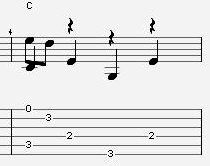
MEASURE 5: MEASURE 6: MEASURE 7:
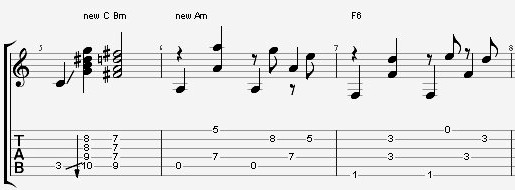
Measure 5: Some neat movement here UP the neck!
Pluck all four string (or brush the strings to get them all to sound).

The Half-F position is really the basis for this measure's "chords up the neck," as well as the Ami chord in Measure 6 coming up.
The difference between the "half-F" and the "half-Fmi" is the
note
on the 3rd string:
Now the half-F position moves down to the fifth through seventh frets, as the half-Fmi position. This is the "new Ami."
Measure 6:
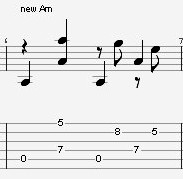
Measure 7:
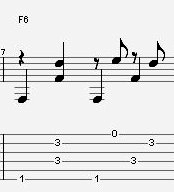
MEASURE 8: MEASURE 9: F6 G (backpicked)
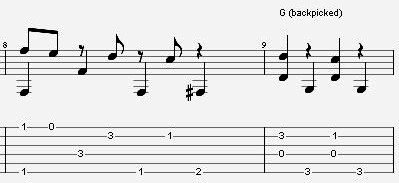
Measure 8 is very similar to Measure 2's F6.
But at the very end of Measure 8, move the last bass up from the first to the second fret on the 6th string.
Measure 9 and 10: This is backpicked (a la
Spikedriver's Moan) for a neat effect:
These are all the tough and/or unusual parts of this arrangement. The rest of the piece follows more obediently along the bottom three frets of the guitar. Keep the bass steady and it'll flow.
This tune has been recorded from Peter Paul and Mary to Bob Dylan. It's one of my favorites. Ronnie's arrangement brings out its haunting beauty.
I hope you enjoy it as much as I have.
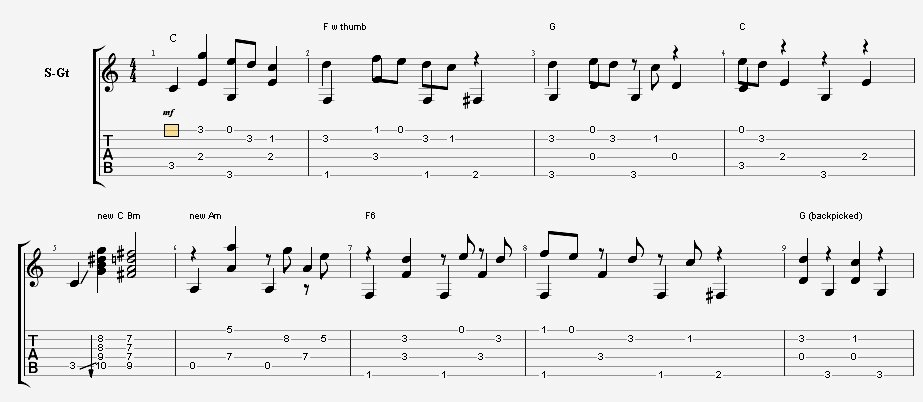
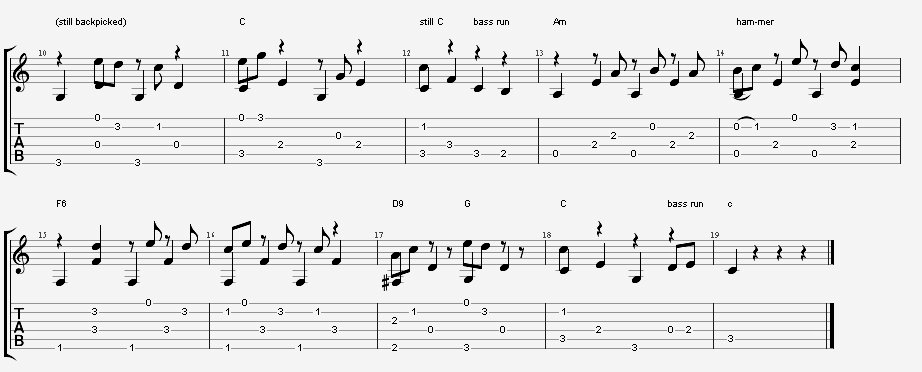
| Back to the Table Of Contents | Trouble reading tablature?: Tablature Help Here |
More info/contact Andy: http://www.andypolon.com